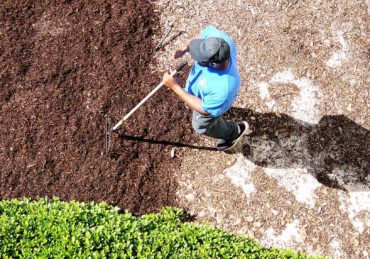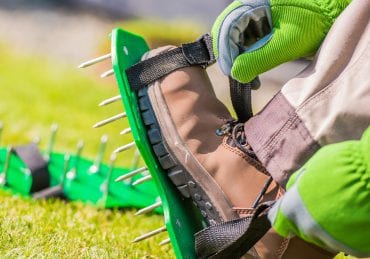Snow mold is a fungal disease that affects cool-season grasses, commonly occurring after snow melts in areas with regular snowfall. It thrives under snow cover when grass remains wet and matted for extended periods. Snow mold appears as circular patches of discolored, matted grass and comes in two main types: gray snow mold (Typhula blight) and pink snow mold (Microdochium nivale). Gray snow mold tenders to cause superficial damage, affecting only the blades, while pink snow mold is more severe, potentially damaging both grass and blades and roots.
Treating snow mold is essential for homeowners in snowy regions, as untreated patches can weaken the lawn, delay spring green-up, and invite further disease. Proper lawn care, such as avoiding excessive thatch, keeping the lawn at a moderate height before winter, and raking leaves before snowfall, can prevent snow mold from developing. Addressing snow mold early ensures your lawn remains healthy and recovers more quickly in spring.
What Causes Snow Mold?
Snow mold forms under specific environmental conditions, primarily affecting lawns in areas with prolonged snow cover. One key factor is snow accumulation before the ground has completely frozen, which traps moisture and creates an ideal environment for fungal growth. The cool, damp conditions beneath the snow allow the snow mold fungus to thrive, as grass remains wet and matted for extended periods. Poor drainage further exacerbates the issue by allowing water to pool, promoting excess moisture that encourages fungal spores to grow and spread.
Another contributing factor is heavy thatch buildup, a layer of dead grass and organic material between the soil and the grass blades. Thatch creates a barrier that holds moisture near the surface, preventing proper air circulation and making the lawn more susceptible to snow mold. When combined with cold temperatures, this excess moisture remains trapped under the snow, creating perfect conditions for both gray and pink snow mold to develop.
Cold temperatures alone don’t cause the problem, but when they are combined with wet, poorly drained conditions, fungal diseases like snow mold take hold. Preventing snow mold involves reducing thatch, ensuring proper lawn drainage, and mowing the grass slightly shorter before winter to minimize moisture retention and promote faster spring recovery.
Role of Snow Cover in Fungal Growth
Extended snow cover creates ideal conditions for snow mold by insulating moisture and trapping cold temperatures underneath. When snow accumulates before the ground freezes completely, the grass stays wet and matted for long periods. This prolonged moisture, combined with the cold temperatures, fosters the growth of fungal spores that cause snow mold. This snow acts like a blanket, preventing the soil from drying out and allowing the fungus to thrive n the damp, cool environment. This leads to the development of snow mold patches, which can damage grass and delay its recovery in spring.
Effective snow clearing techniques can reduce snow mold risk by minimizing prolonged snow cover that traps moisture and promotes fungal growth.
The Impact of Organic Debris
Organic debris, such as fallen leaves and grass clipping, can trap moisture under snow, increasing the risk of snow mold. When this debris is left on the lawn before snowfall, it creates a layer that holds in moisture, preventing proper air circulation and drying. This moisture, combined with the cold, damp conditions beneath the snow, fosters the perfect environment for fungal growth. The wet, matted debris encourages snow mold spores to thrive, leading to the development of discolored, matted patches of grass in the spring. Clearing the lawn of debris before winter reduces the risk of snow mold formation.
Types of Snow Mold
Snow mold becomes visible in early spring once the snow melts, and spotting it is essential to begin treating it before further lawn damage occurs. The most common sign of snow mold is the appearance of circular patches of dead or matted grass, typically ranging from a few inches to a foot in diameter. These patches can be white, gray, or pink in color, depending on the type of snow mold.
Gray snow mold tends to appear as whitish-gray patches and typically affects the blades of the grass without penetrating the root system. The patches may look frosty or cotton-like in texture. Gray snow mold is generally less severe, as it only damages the above-ground portion of the grass, allowing for easier recovery once temperatures increase.
In contrast, pink snow mold appears in circular patches with a pinkish hue. It’s more aggressive than gray snow mold and can damage both the grass blades and roots, making it more challenging for the lawn to recover. Pink snow mold thrives in slightly warmers conditions under snow and is particularly harmful if left untreated.
Both types of snow mold leave the grass looking matted and discolored. As the lawn beings to dry, it’s important to rake out these patches gently, allowing air to circulate and the grass to breathe. Promptly addressing snow mold will help prevent further damage and encourage quicker recovery for a lush, healthy lawn.
Gray Snow Mold (Typhula Blight)
Gray snow mold is a fungal disease that prefers cooler temperatures, typically developing under prolonged snow cover when grass remains wet and cold. It appears as circular patches of matted, dead grass with a grayish-white color, often giving the grass a frosty or cotton-like texture. Unlike pink snow mold, gray snow mold primarily damages the grass blades without affecting the roots, making it less severe. It thrives when snow accumulates before the ground freezes fully, and the grass stays moist. While gray snow mold is unsightly, lawns can generally recover once conditions warm up.
Pink Snow Mold (Microdochium Patch)
Pink snow mold thrives in slightly warmer conditions than gray snow mold, typically developing under late winter or early spring snow cover. It appears as circular patches of matted, dead grass with a distinctive pinkish hue, often more aggressive than gray snow mold. Pink snow mold can damage both grass blades and roots, making recovery more difficult. This type of snow mold forms when moisture is trapped under snow or in cool, wet conditions, particularly in areas where snow accumulates after a late-season thaw. Early detection and treatment are essential to prevent severe lawn damage.
How to Treat Snow Mold
Treating snow mold begins with encouraging natural recovery methods, as many lawns can bounce back once temperatures rise and the ground dries out. The first step is to gently rake the affected areas to loosen matted grass and improve airflow. This helps dry out the grass more quickly, discouraging further fungal growth and promoting healthy regrowth. Be careful not to rake too aggressively, as the lawn is often fragile after winter.
Once the lawn is raked, allow it to dry thoroughly. In many cases, especially with gray snow mold, this alone is sufficient for recovery. The grass will naturally fill in the affected areas as it beings to grow in the warmer weather. Watering should be done sparingly as first, as excess moisture can prolong fungal activity.
If the damage is more severe, particularly from pink snow mold, additional treatments may be necessary. Applying a balanced fertilizer in early spring can help strengthen the grass, promoting faster recovery. In cases where the lawn is slow to recover or patchy, overseeding may be needed to fill in bare spots.
Avoid using excessive fungicides unless absolutely necessary, as they may not be required for mild cases of snow mold. Fungicides should be reserved for serious outbreaks where large areas of the lawn are affected and natural recovery is insufficient. Regular lawn care practices such as proper mowing, dethatching, and ensuring adequate drainage can prevent future snow mold outbreaks and keep the lawn healthy.
Raking and Promoting Lawn Drying
Gently raking affected areas is an effective way to help a lawn recover from snow mold. Snow mold leaves grass matted and compacted, which traps moisture and restricts airflow, creating a favorable environment for fungal growth. By carefully raking the matted areas, you break up the compacted grass, allowing air to circulate more freely and helping the lawn dry out faster. Improved airflow prevents further fungal development and encourages healthy grass regrowth. It’s important to be gentle when raking, as the grass can be fragile after winter, but this simple step significantly accelerates the recovery process.
Using Fungicides for Severe Cases
Fungicides are appropriate for treating snow mold when the infection is severe, covering large areas of the lawn or when natural recovery methods like raking aren’t sufficient. There are two main types of fungicides: protectant and systemic. Protectant fungicides are applied before snow or wet conditions to prevent snow mold spore from germinating. They remain on the surface of the grass, offering protection for a limited period, usually lasting up to 30 days. These are ideal for preventing outbreaks in high-risk areas but must be reapplied if conditions persist.
Systemic fungicides, on the other hand, are absorbed by the grass and provide longer-lasting protection, as they move through the plant tissue to treat existing infections. Systemic fungicides can last for several weeks to a few months, making them more suitable for treating active snow mold infections. While fungicides are helpful in extreme cases, they should be used judiciously, with preference given to natural recovery whenever possible to avoid overuse of chemicals.
Preventing Snow Mold
Preventing snow mold requires proactive lawn care practices that minimize the conditions favorable for fungal growth. Key strategies to protect your lawn include:
- Proper Mowing: Before winter, mow your lawn to the appropriate height, around 2.5 to 3 inches for most cool-season grasses. Grass that’s too long can mat down under snow, trapping moisture, while grass that’s too short can stress the lawn, making it more vulnerable to disease.
- Raking and Debris Removal: Clear the lawn of fallen leaves, twigs, and grass clippings before snowfall. Organic debris traps moisture and creates the ideal conditions for snow mold to develop under the snow.
- Dethatching: Regularly dethatch your lawn if thatch exceeds by half an inch. Thatch buildup creates a barrier that holds moisture near the grass surface, increasing the likelihood of snow mold. Dethatching in the fall ensures better airflow and drainage.
- Aeration: Aerating the lawn in early fall helps relieve soil compaction and improves water drainage. Well-drained soil dries faster, reducing moisture accumulation that can contribute to snow mold.
- Fertilizing Properly: Avoid heavy nitrogen fertilization in late fall. Too much nitrogen promotes excessive growth, which can become more susceptible to snow mold. Instead, use a balances fertilizer with potassium, which strengthens roots and improves disease resistance.
- Snow Management: In areas prone to heavy snow, manage snow piles by redistributing them more evenly across the lawn. Excessive snow buildup from snow plowing in certain spots can lead to prolonged moisture retention, increasing the risk of snow mold.
By implementing these lawn care practices, you can significantly reduce the risk of snow mold and maintain a healthier lawn through the winter months.
Core Aeration in the Fall
Core aeration is a valuable lawn care practice that reduces soil compaction and improves water drainage, especially before winter. By removing small plugs of soil, aeration creates space for air, water, and nutrients to penetrate deep into the root zone. This helps prevent water from pooling on the surface, which can lead to excess moisture that encourages snow mold formation. Aeration also allows roots to grow deeper and stronger, making the lawn more resilient against winter stresses. Performing core aeration in the fall promotes better drainage and ensures that lawn is in optimal condition to withstand cold and snow.
Proper Lawn Mowing & Debris Removal
Mowing the lawn to the right height before winter, typically around 2.5 to 3 inches, is crucial for preventing snow mold. Grass that is too long can become matted under snow, trapping moisture, which creates the perfect environment for snow mold to develop. Conversely, grass that’s too short can stress the lawn, leaving it more vulnerable to disease. Additionally, removing organic debris such as leaves and grass clippings is essential. Debris can trap moisture and block airflow, increasing the risk of fungal growth. Proper mowing and debris removal help the lawn stay dry and resilient through winter.
Lawn Recovery After Snow Mold
Restoring a lawn after snow mold damage involves several key steps to promote healthy regrowth. First, begin by gently raking the affected areas to loosen matted grass and improve airflow. This helps the lawn dry out and prevents further fungal growth. If large patches of grass have been killed, the next step is reseeding. Choose a seed mix suitable for your lawn type and overseed the bare spots, ensuring good seed-to-soil contact by lightly raking the soil and covering with a thin layer of topsoil or straw to protect the seeds.
Once reseeded, apply a balanced, slow-release fertilizer to provide essential nutrients that support recovery. A fertilizer with a higher nitrogen content in early spring helps promote leaf and shoot growth, while a balanced formula will encourage both root and top growth.
Water the lawn properly, keeping the soil consistently moist but not waterlogged. Watering should be done deeply and infrequently to encourage strong root growth. Be mindful to avoid overwatering, as excess moisture can promote further fungal issues.
Continue mowing regularly but keep the grass at a moderate height to reduce stress while it recovers. With proper reseeding, fertilization, and consistent care, your lawn should fully recover from snow mold damage and return to a lush, healthy state.
When to Call a Lawn Care Professional
Homeowners with severe snow mold infestations or those struggling to manage recurring issues may benefit from contacting a professional lawn care service. Severe cases, particularly with extensive pink snow mold that damages both grass blades and roots, often require expert assessment and treatment. Professionals can apply the appropriate fungicides and ensure the correct timing and coverage, which is essential to prevent future outbreaks. Additionally, professional services can help optimize lawn health through core aeration, dethatching, and customized fertilization schedule to reduce snow mold risks.
LawnGuru can help prevent snow mold by offering essential services such as aeration, dethatching, fall leaf cleanups, and regular lawn care. Taking proactive measures to prevent snow mold is essential to minimizing the conditions favorable for snow mold growth and significantly reduces the risk of snow mold, keeping your lawn healthy throughout the winter months.
FAQs About Snow Mold
How long does snow mold last?
Snow mold typically lasts for a few weeks after snow melts in early spring. Most lawns recover naturally as temperatures rise and the grass dries out, though severe cases may require additional care like raking, reseeding, or treatment.
Can snow mold harm pets or humans?
Snow mold is generally not harmful to pets or humans. However, in rare cases, people with allergies or respiratory sensitivities may experience mild irritation when exposed to mold spores.
Is snow mold more likely in certain climates?
Yes, snow mold is more likely in cold climates with prolonged snow cover, particularly where snow falls before the ground freezes, trapping moisture beneath. It’s common in regions with heavy, wet snowfall and poor lawn drainage.





